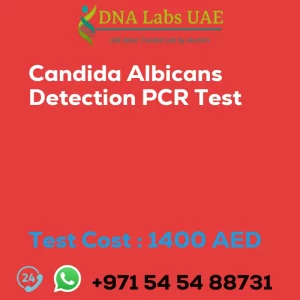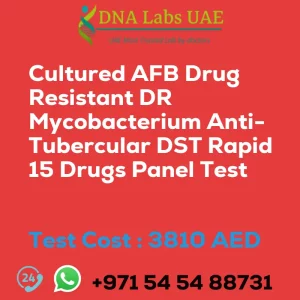Factor V Leiden Detection RNA Detection Qualitative Test
Components: Factor V Leiden Detection RNA Detection Qualitative Test
Price: 1200.0 AED
Sample Condition: Whole Blood
Report Delivery: 3rd Working Day (Email: 36 hours, On phone: 24 hours)
Method: Real Time PCR
Test Type: Viral
Doctor: Physician
Test Department: Genetics
Pre Test Information: Need to sign Consent document and bring any clinical history of patient for Factor V Leiden Detection (RNA Detection) Qualitative Test
Test Details
Factor V Leiden is a genetic mutation that increases the risk of developing abnormal blood clots in veins, a condition known as venous thromboembolism. The most common mutation associated with Factor V Leiden is a single nucleotide change in the factor V gene, resulting in the replacement of a guanine (G) with an adenine (A) at position 1691 (G1691A).
The qualitative test for Factor V Leiden detection involves the detection of this specific mutation in the factor V gene. The test is usually performed using a technique called polymerase chain reaction (PCR), which amplifies the specific region of the gene containing the mutation.
Here is a general overview of the steps involved in the qualitative test for Factor V Leiden detection:
- Sample collection: A blood sample is collected from the individual being tested. The sample is typically collected using a standard venipuncture technique.
- DNA extraction: The DNA is extracted from the blood sample using various methods, such as a commercial DNA extraction kit or a manual extraction protocol.
- PCR amplification: The extracted DNA is subjected to PCR amplification using specific primers that target the region of the factor V gene containing the G1691A mutation. The primers are designed to specifically amplify the mutated allele.
- Gel electrophoresis: The PCR products are separated by size using gel electrophoresis. The gel is stained with a DNA-specific dye, and the DNA bands are visualized under UV light.
- Result interpretation: The presence or absence of the specific DNA band corresponding to the G1691A mutation indicates whether the individual carries the Factor V Leiden mutation or not. If the band is present, it suggests the presence of the mutation, while the absence of the band indicates the absence of the mutation.
It’s important to note that this is a qualitative test, which means it only detects the presence or absence of the mutation. It does not provide information about the quantity of mutated DNA or the risk of developing venous thromboembolism. For a more comprehensive evaluation, additional tests may be required, such as quantitative PCR or other laboratory tests to assess the risk of clotting disorders.
| Test Name | Factor V Leiden Detection RNA Detection Qualitative Test |
|---|---|
| Components | |
| Price | 1200.0 AED |
| Sample Condition | Whole Blood |
| Report Delivery | 3rd Working Day Email:-36 hours. On phone: 24 hours |
| Method | Real Time PCR |
| Test type | Viral |
| Doctor | Physician |
| Test Department: | Genetics |
| Pre Test Information | Need to sign Consent document and bring any clinical history of patient forFactor V Leiden Detection (RNA Detection) QualitativeTest |
| Test Details |
Factor V Leiden is a genetic mutation that increases the risk of developing abnormal blood clots in veins, a condition known as venous thromboembolism. The most common mutation associated with Factor V Leiden is a single nucleotide change in the factor V gene, resulting in the replacement of a guanine (G) with an adenine (A) at position 1691 (G1691A). The qualitative test for Factor V Leiden detection involves the detection of this specific mutation in the factor V gene. The test is usually performed using a technique called polymerase chain reaction (PCR), which amplifies the specific region of the gene containing the mutation. Here is a general overview of the steps involved in the qualitative test for Factor V Leiden detection: 1. Sample collection: A blood sample is collected from the individual being tested. The sample is typically collected using a standard venipuncture technique. 2. DNA extraction: The DNA is extracted from the blood sample using various methods, such as a commercial DNA extraction kit or a manual extraction protocol. 3. PCR amplification: The extracted DNA is subjected to PCR amplification using specific primers that target the region of the factor V gene containing the G1691A mutation. The primers are designed to specifically amplify the mutated allele. 4. Gel electrophoresis: The PCR products are separated by size using gel electrophoresis. The gel is stained with a DNA-specific dye, and the DNA bands are visualized under UV light. 5. Result interpretation: The presence or absence of the specific DNA band corresponding to the G1691A mutation indicates whether the individual carries the Factor V Leiden mutation or not. If the band is present, it suggests the presence of the mutation, while the absence of the band indicates the absence of the mutation. It’s important to note that this is a qualitative test, which means it only detects the presence or absence of the mutation. It does not provide information about the quantity of mutated DNA or the risk of developing venous thromboembolism. For a more comprehensive evaluation, additional tests may be required, such as quantitative PCR or other laboratory tests to assess the risk of clotting disorders. |








